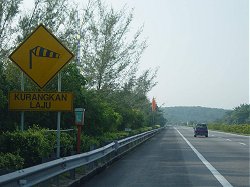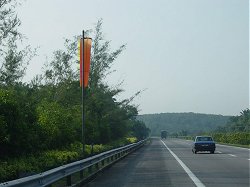

In recent press reports, the Works Minister had repeatedly singled out the Melaka section of the North South Expressway (NSE), i.e. from Alor Gajah to Ayer Keroh, and was adamant that the current speed cap would be maintained for some inexplicable reason.
The existing speed limits for cars on NSE have been established more than a decade ago when the highway was first opened. Since then, two speed limits i.e. 90kph and 110kph have been in use at different stretches of the expressway.
I frequently travel the southern section of NSE from my home in Petaling Jaya to Muar/Pagoh. I am therefore very familiar with the condition of this section of the expressway. Currently from Sungei Besi Toll to Pagoh, the expressway has two stretches with a cap of 90kph. The first is from Sg. Besi Toll to Bangi (Bangi stretch) and the other is from Alor Gajah to Ayer Keroh (Melaka stretch).
The rationale for a lower speed limit on Bangi stretch is heavy traffic volume on both directions; while on Melaka stretch is crosswinds.
It is true that traffic on the Bangi stretch has always been heavy. But this section of the expressway has since been expanded to three lanes in both directions and therefore it would be appropriate to remove the speed restriction unless an traffic study has shown otherwise.
Though crosswinds are said to prevail at a few locations along the Melaka stretch, I have not had the opportunity to encounter any in all my years of travel along this stretch. Currently there are signboards and wind cones placed in a number of locations to forewarn motorists of crosswinds. But most of the time I see the wind cones hanging almost motionless on top of their poles. However, on a few occasions when I was in my 3-door Susuki Vitara cruising along at around 90kph, my car would suddenly wobble, not by a strong gust of crosswind but by an expressed bus zooming past me!
 |
 |
The Melaka stretch covers a distance of about twenty kilometers. It is a long, relatively straight and level stretch of highway. Instead of imposing a 90kph limit for the whole stretch due to infrequent crosswinds at only a couple of locations, erecting electronic signboards to forewarn motorists will be a more practical solution.
On the other hand, the portion of the NSE in Negri Sembilan between the Labu and Senawang interchanges is a winding and hilly two-lane highway trespassing through a busy urban area. It is a seven-kilometer long stretch with three busy interchanges in between. The traffic is always heavy and it is not often that one can travel at the speed limit of 110kph. Therefore a 100kph-speed cap should be imposed here rather than on the Melaka stretch.
From the above, it appears that the authorities concerned have not carried out adequate traffic studies or road safety audits before making decisions to revise the speed limits of our highways.